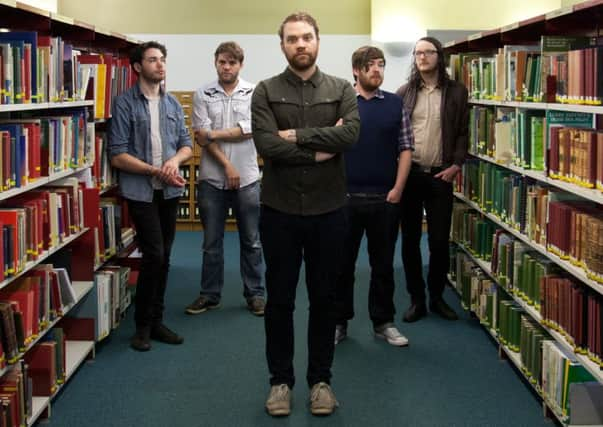Album reviews: Frightened Rabbit | Mull Historical Society | Alun Woodward


The last couple of years have marked something of a watershed for Frightened Rabbit, one of the most ardently loved Scottish bands of the past decade, with frontman Scott Hutchison relocating to the US and embarking on a solo project, Owl John.
With the rest of the members still based in Scotland, the band came together to record their fifth album in New York. Painting of a Panic Attack (**) has been produced by Aaron Dessner of The National, another band of brothers who trade more in emotive atmospheres than striking songwriting.
Advertisement
Hide AdAdvertisement
Hide AdHutchison’s intention to move on from the maudlin is not immediately apparent. Death Dream opens the album with quavery vocals and sonorous piano, before gradually layering up the vocals into an indie folk canon.
But despite the angsty title and the suggestion of homesickness which pervades some of the lyrics, there is a lighter touch in play here as the group toy more with electronic elements – perhaps the result of not being able to gather together in one room so easily any more. Often aspects of the arrangements are more striking than the songs they support – the reverberating guitar lines and echoing drums are what catch the ear in Get Out.
Elsewhere, there is too much that drifts in one ear and out the other. Woke Up Hurting is very much in the Radio 1-endorsed blandly rootsy pop bracket, with enough of a hook to pass the inoffensive background listening test. An Otherwise Disappointing Life, a study in mild consternation, is cut from the same cloth, while the ballads I Wish I Was Sober and Die Like A Rich Boy fail to deliver on their promising titles.
The band shake it out/off more effectively on Break, with a thumping beat, feisty rhythm guitar and Hutchison declaiming from the rooftops while still retaining a core pop appeal. Lump Street is another one to skip forward to, striking a certain rich moodiness for most of its running time, then breezing through in the closing moments, almost achieving lift-off with its light but pacey backing.
At least they are not labouring the point as Colin MacIntyre is prone to do on his latest album in Mull Historical Society guise. MacIntyre has no trouble crafting a pop tune but there is something heavy-handed, even strained in the execution of most of the songs on Dear Satellite (**).
Album centrepiece The Ballad Of Ivor Punch, inspired by the title character from his debut novel The Letters of Ivor Punch, and the wide-eyed, widescreen closing track Farewell to Finisterre, with its shades of The Waterboys’ Whole of the Moon, are easily the most accomplished moments here, both highlighting MacIntyre’s yarn-spinning skills.
Former Delgados frontman Alun Woodward releases his first new music since briefly inhabiting his Lord Cut-Glass incarnation in 2009. Music From Battle Mountain (****) perpetuates The Delgados’ yen for cycling in grand style, being the soundtrack to a new documentary about “Flying Scotsman” Graeme Obree and his attempt to beat the prone cycling speed record.
Advertisement
Hide AdAdvertisement
Hide AdWoodward mixes predominantly instrumental acoustic and electronic tracks to create an effective and atmospheric score worthy of consumption in its own right, setting the scene with ominous organ drone and funereal chord progressions before eventually picking out some notes, and then fleshing out the score with woozy guitar and piano on Slide, wiggy nursery rhyme chimes on In School and a mesmeric trip into psychedelic exotica on Afterwards. Fiona Shepherd
CLASSICAL: Schumann: Cello Concerto & Piano Trio No 1 | Rating: **** | Harmonia Mundi
The idea of a recording series centred on Schumann’s piano trios, and combining them respectively with contextual Schumann concertos, isn’t the only refreshing aspect of a series whose latest release partners the Piano Trio No 1, Op 63 with the Cello Concerto, Op 129. For the collaboration – with piano trio Isabelle Faust (violin), Jean-Guihen Queyras (cello) and Alexander Melnikov (fortepiano) – also includes the svelte precision of the gut-strung Freiburger Barockorchester under Pablo Heras-Casado. This brings a vivid immediacy to the Cello Concerto, the unforced robustness of Queyras’ solo playing completely in tune with the orchestra’s visceral rawness. It takes a bit of getting used to, but ultimately draws out all that is manful and emotionally direct in the music. Where opulence is called for Faust, Queyras and Melnikov provide it in spades. This is a golden rich performance, with highly inventive textures, that avoids slipping into sentimentality. Ken Walton
JAZZ: Per Oddvar Johansen: Let’s Dance Edition Records | Rating: ****
Dancing isn’t some flightly, bopping-about affair for Norwegian drummer Per Oddvar Johansen. It is a serious if solemnly lyrical business, going by the opening title track of his album with pianist Helge Lien and Torben Snekkestad on saxophones and the hybrid reed trumpet, which sounds out over tolling piano and flickering cymbals and drum taps, giving the number a sweeping melancholy which seems to echo the misty forest slopes pictured on the sleeve.
By comparison, No 7, which follows on, is positively smoochy, a lissom melody looking for a dancefloor, while in contrast are the trio’s more abstract creations – the sonorous creaks and booms of Forest Flower, the expansively echoing Flying and an incongruous, back-porch interlude, Uluru (for Anette), with its strummed and sliding guitars and birdsong.
Snekkestad’s haunting sax returns in Panorama and Families, in an album which combines warmth of tone with a decidedly Nordic splendour. Jim Gilchrist